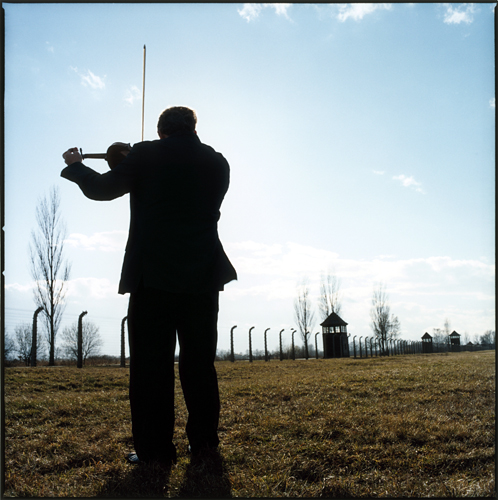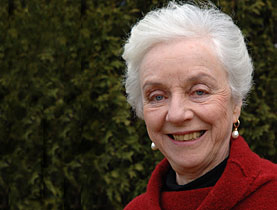“Violins of Hope” keep Holocaust memory alive

Eighteen violins which survived Jewish ghettos and Nazi concentration camps are being displayed and played as part of the 46th Sion International Music Festival.
Israeli violin maker Amnon Weinstein, who is in charge of the exhibition, tells swissinfo.ch how – and why – he has spent 15 years tracking down instruments connected to the Holocaust.
Weinstein, 71, learnt his trade from his father and now heads a world-renowned workshop in Tel Aviv. Several of the instruments on which he has worked have been played in concerts in Istanbul, Paris and across the United States.
This will also be the case in Madrid on January 27, International Holocaust Remembrance Day.
The exhibition, The Violins of Hope, (see box) is being held in a former prison in the southwestern town of Sion. It is the first time ever that so many such instruments have been the subject of lectures, workshops and concerts.
swissinfo.ch: Where did you get the idea of restoring violins linked to the Holocaust?
Amnon Weinstein: One of my apprentices in Tel Aviv came from Dresden in Germany and he had a really poor knowledge of what had happened during the Holocaust. But he was fascinated by it and went to museums and read books. He understood that I was an important “way in” to the subject. At the time I didn’t have any violins from the ghettos or camps, instead they were connected to the creation of the Israel Philharmonic Orchestra, founded [in 1936] by violinist Bronislaw Huberman and conducted by Arturo Toscanini.
For two years this student kept on at me to give a lecture, but I really didn’t want to touch this material. It was too difficult, too emotional for me. Ultimately, however, I accepted. After two years of research I gave a talk in Dresden for the association of German luthiers.
I appealed on the radio for stories, and slowly the instruments appeared. Today I’m responsible for 26 instruments from the Holocaust and the Israel Philharmonic Orchestra. I own some, others belong to museums or individuals.
The project has snowballed and taken over my life. I look for documents, photos – it never stops. On the contrary: it captivates me more and more. It’s important to know that there are very few documents on any of these violins and that the people who played on them in the ghettos or camps didn’t play on them afterwards – they couldn’t. That’s understandable.
I’m trying to find out the complete history of these violins, but above all they have to be played. One must hear their tone, which tells a story, a quality. That’s the case here at Sion with these concerts. It’s wonderful.
swissinfo.ch: Can you explain more about the origin of the violins?
A.W.: Almost all were made in Germany and Czechoslovakia in small workshops. Others were made by luthiers, such as Wagner. I look for them in Europe and to a lesser extent in Israel. After the war 85 per cent of refugees left for the US. They wanted to be safe. Some of my American colleagues get in touch with me when they come across a violin with the Star of David. Nowadays, with photos and the internet, it’s easy.
swissinfo.ch: What connects you to these violins?
A.W.: First of all I’m a violin maker. Then there’s my family. One day my sister compiled a list of our relatives killed by the Germans. Some 380 names were on it. My father was a Zionist and against the advice of my grandfather came to Israel in 1938. But apart from my mother and father, my entire family was killed. This mausoleum of sound [made by the violins] is also a mausoleum for my family.
swissinfo.ch: Is it fair to say that you repair these violins?
A.W.: It’s more than that. Restoring a violin made by a good luthier isn’t a problem. But most of these are in very poor condition, having been in the ghettos or camps.
On one of them I had to spend a year and a half – a quarter of it is new. The musician had been forced to play in the rain, a violin’s worst enemy. But it was vital to restore it. It had five Stars of David, something you don’t see every day.
swissinfo.ch: Are there any specific difficulties you face?
A.W.: If I had difficulties, that would mean I was in the wrong job. Everything is repairable: there’s no problem that can’t be resolved. But when you touch a violin like the one that was at Auschwitz, you understand its history. Repairing them is hard on an emotional level rather than a technical one. But I’ll continue to renovate these violins for as long as my hands let me.
swissinfo.ch: What do these instruments tell us?
A.W.: We only have photos of the victims, not their voices. These violins are the voices of the victims. Six million victims.
swissinfo.ch: How do these violins reflect the fate of European Jews?
A.W.: In practically every Jewish household there was someone who played the violin. As one Jewish writer once said, count the instruments on the wall and you’ll know how many men are in that family.
swissinfo.ch: Do you feel you are on a mission, giving life to these violins?
A.W.: Absolutely. My son and I have devoted the equivalent of €180,000 (SFr235,000) in work hours for this. It’s a mission in terms of memory. Everyone must understand that what happened during the Holocaust mustn’t happen again.
swissinfo.ch: Do you fear that this memory will one day disappear – that deniers will get the upper hand?
A.W.: Why one day? Many people today say the Holocaust never happened! I know people who were in the camps. But despite the amount of witnesses and documents, I’ve seen someone get out a tape measure, take some measurements and declare that it would be impossible to kill so many people in such a small gas chamber. What idiocy!
Pierre-François Besson in Sion, swissinfo.ch (Translated from French by Thomas Stephens)
At the 46th Sion International Music Festival, “Capital of the Violin” will host from August 18-September 15 in collaboration with the Cantonal Museums of Valais “The Violins of Hope”.
Eighteen violins, from a collection of 24, recovered from the Holocaust and restored by the master violin maker Amnon Weinstein will be displayed in the historical setting of the “Ancien Pénitencier” of Sion – a former prison which has been converted into an Art Museum.
Nazi Germany banned Jewish composers such as Mendelssohn, Mahler and Offenbach, but made a cult of Liszt, von Suppé and Wagner.
From 1940, the SS organised prisoner orchestras in almost all extermination camps. At Auschwitz-Birkenau, between 1940 and 1943 five ensembles played on a daily basis and many smaller orchestras were created in the surrounding camps.
“Music accompanied every moment of the prisoners’ wretched routine. During the interminable roll calls, executions and torture sessions, separating those arriving by train, orchestras would indefatigably play jolly and lively tunes.” (Source: “The Violins of Hope”)

In compliance with the JTI standards
More: SWI swissinfo.ch certified by the Journalism Trust Initiative















You can find an overview of ongoing debates with our journalists here . Please join us!
If you want to start a conversation about a topic raised in this article or want to report factual errors, email us at english@swissinfo.ch.